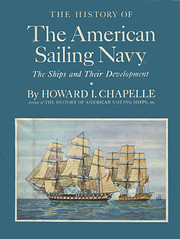

Fai clic su di un'immagine per andare a Google Ricerca Libri.
|
Sto caricando le informazioni... The History of the American Sailing Navy: The Ships and Their Developmentdi Howard I. Chapelle
 Nessuno Sto caricando le informazioni...
Iscriviti per consentire a LibraryThing di scoprire se ti piacerà questo libro. Attualmente non vi sono conversazioni su questo libro.   ) )An older book (1949), although the copy I have is obviously a more recent reprint (because it has a 13-digit ISBN number, and these weren’t introduced until 2007). The title is a misleading; this is not The History of the American Sailing Navy; there’s next to nothing about naval actions during the period. Instead it’s an extremely detailed treatise on the way the ships were built during the period. The author, Howard I. Chapelle, had tracked down hundreds of ship plans, ranging from the massive Pennsylvania and the way down to gunboats and the captain’s gig. Obviously, this is of most use to a ship modeler rather than the naval historian. Still, there are a few cases where information about ship construction sheds light on military actions. I’ve been reading about the War of 1812 recently, and noted that while the naval actions on the high seas get the most coverage the ones on the Great Lakes were actually the most decisive. In that context I was particularly interested in Chapelle’s discussion of the shipbuilder Noah Brown, who made his way across upstate New York to Presque Isle, Pennsylvania in the dead of winter, and, assisted by a small group of carpenters, managed to build two brigs, a schooner, three gunboats, a blockhouse, a guardhouse, a cook and mess building, a barracks, four floats to lift the ships over the bar, all the ships’ boats, and all their gun carriages by July 1813 – leading to Perry’s victory at Put-In-Bay in September and American control of the upper lakes. Also of interest is Chapelle’s discussion of the 120-gun ship Pennsylvania, the largest sailing vessel ever built for the U.S. Navy. Chapelle theorizes the Pennsylvania, although capable of ocean cruising, was intended as a blockade breaker. The idea was that the Pennsylvania, accompanied by whatever 74s and frigates were available, would sortie and overwhelm any force an enemy could reasonably station on blockade duty, allowing the frigates to escape and go commerce raiding. The idea never got tested, and the Pennsylvania never fired her guns in anger (in fact, although launched in 1837, she only put to sea once) before she was burned at her dock in Norfolk to prevent the Confederates from seizing her in 1861. Chapelle debunks the myth that the Constellation, currently on display in Baltimore as a museum ship, is the Revolutionary War frigate of the same name. It was very hard to get money to build new ships in the early 19th century, but money for repair was always available. Therefore, the US Navy exercised creative accounting and “repaired” old ships by building new ones of the same name. Chapelle acknowledges that there might be little bits and pieces salvaged from the original 1797 Constellation in the 1854 one but they can’t reasonably be called the same ship. In a related note, Chapelle notes that there was a problem in providing Navy captains with suitable commands in the years between the War of 1812 and the Civil War. At the time there was no mandatory retirement age in the Navy, nor was there a rank of “Admiral”. As a captain’s seniority increased, he was supposed to get better and better ships to command, but ships were traditionally rated by the number of guns they carried and as gun power increased and explosive shells were introduced the tendency was to build smaller ships with a few powerful guns rather than larger ships with many less powerful ones. As an example, the original Constellation was a frigate with two gundecks; when she was “rebuilt” it was as a sloop, with single gun deck. Technically, a sloop wasn’t a “rated” ship at all, even though with the introduction of shell guns it was as or more powerful than earlier ships ranked as “1st rate”. The Royal Navy had the same problem; it was never really settled and was quietly abandoned with the introduction of armored, steam-powered warships. Excellent if you’re a modeler, useful for specialist in naval history, but you’ll need to find out the details of (for example) Constitution vs. Guerriere elsewhere. nessuna recensione | aggiungi una recensione
Risorse esterne che parlano di questo libro
|
Discussioni correntiNessunoCopertine popolari
 Google Books — Sto caricando le informazioni... Google Books — Sto caricando le informazioni...GeneriSistema Decimale Melvil (DDC)623.822Technology Engineering and allied operations Military Engineering and Marine Engineering Naval architecture; Shipbuilding History of Naval Architecture Sailing VesselsClassificazione LCVotoMedia: (3.42) (3.42)
Sei tu?Diventa un autore di LibraryThing. |
||||||||||||||||||||||||||||||||||||||||||||||||||||||||||||||||||||||||||||||||||||||||||||||||||||||||||||||||||||||